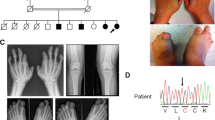Abstract
Rhizomelic chondrodysplasia punctata is a rare autosomal recessive disorder characterized by stippled epiphyses and rhizomelic shortening of the long bones. We report 3 subjects of rhizomelic chondrodysplasia punctata from India and thePEX7 mutations identified in them. The commonPEX7-L292X allele, whose high frequency is due to a founder effect in the northern European Caucasian population, was not identified in these patients. Instead, 2 novel alleles are described, including 64_65delGC, which was present on a singlePEX7 haplotype and could represent a common allele in the Indian population.
Similar content being viewed by others
References
Basbug M, Serin IS, Ozcelik B, Gunes T, Akcakus M, Tayyar M, 2005. Prenatal ultrasonographic diagnosis of rhizomelic chondrodysplasia punctata by detection of rhizomelic shortening and bilateral cataracts. Fetal Diagn Ther 20: 171–174.
Björkhem I, Sisfontes L, Boström B, Kase BF, Blomstrand R, 1986. Simple diagnosis of the Zellweger syndrome by gas-liquid chromatography of dimethylacetals. J Lipid Res 27: 786–791.
Braverman N, Chen L, Lin P, Obie C, Steel G, Douglas P, et al. 2002. Mutation analysis of PEX7 in 60 probands with rhizomelic chondrodysplasia punctata and functional correlations of genotype with phenotype. Hum Mutat 20: 284–297.
Braverman N, Steel G, Lin P, Moser A, Moser H, Valle D, 2000.PEX7 structure, alternative transcripts, and evidence for a founder for the frequent RCDP, L292ter. 63: 181–192.
Fryburg JS, Kelly TE, 1996. Chondrodysplasia punctata, humero-metacarpal type: a second case. Am J Med Genet 64: 493–496.
Hertzberg BS, Kliewer MA, Decker M, Miller CR, Bowie JD, 1999. Antenatal ultrasonographic diagnosis of rhizomelic chondrodysplasia punctata. J Ultrasound Med 18: 715–718.
Krakow D, Williams J 3rd, Poehl M, Rimoin DL, Platt LD, 2003. Use of three-dimensional ultrasound imaging in the diagnosis of prenatal-onset skeletal dysplasias. Ultrasound Obstet Gynecol 21: 467–472.
Kumada S, Hayashi M, Kenmochi J, Kurosawa S, Shimozawa N, Kratz LE, et al. 2001. Lethal form of chondrodysplasia punctata with normal plasmalogen and cholesterol biosynthesis. Am J Med Genet 98: 250–255.
Savarirayan R, Boyle RJ, Masel J, Rogers JG, Sheffield IJ, 2004. Long-term follow-up in chondrodysplasia punctata, tibial metacarpal type, demonstrating natural history. Am J Med Genet 124: 148–57.
Shanske AL, Bernstein L, Herzog R, 2007. Chondrodysplasia punctata and maternal autoimmune disease: a new case and review of the literature. Pediatrics 120: e436–41.
Zenger-Hain J, Craft DA, Rizzo WB, 1992. New Developments in Fatty Acid Oxidation. In: Coates PM and Tanaka K, eds. New York, Wiley-Liss 399–407.
Author information
Authors and Affiliations
Corresponding author
Rights and permissions
About this article
Cite this article
Phadke, S.R., Gupta, N., Girisha, K.M. et al. Rhizomelic chondrodysplasia punctata type 1: report of mutations in 3 children from India. J Appl Genet 51, 107–110 (2010). https://doi.org/10.1007/BF03195717
Received:
Revised:
Accepted:
Issue Date:
DOI: https://doi.org/10.1007/BF03195717




